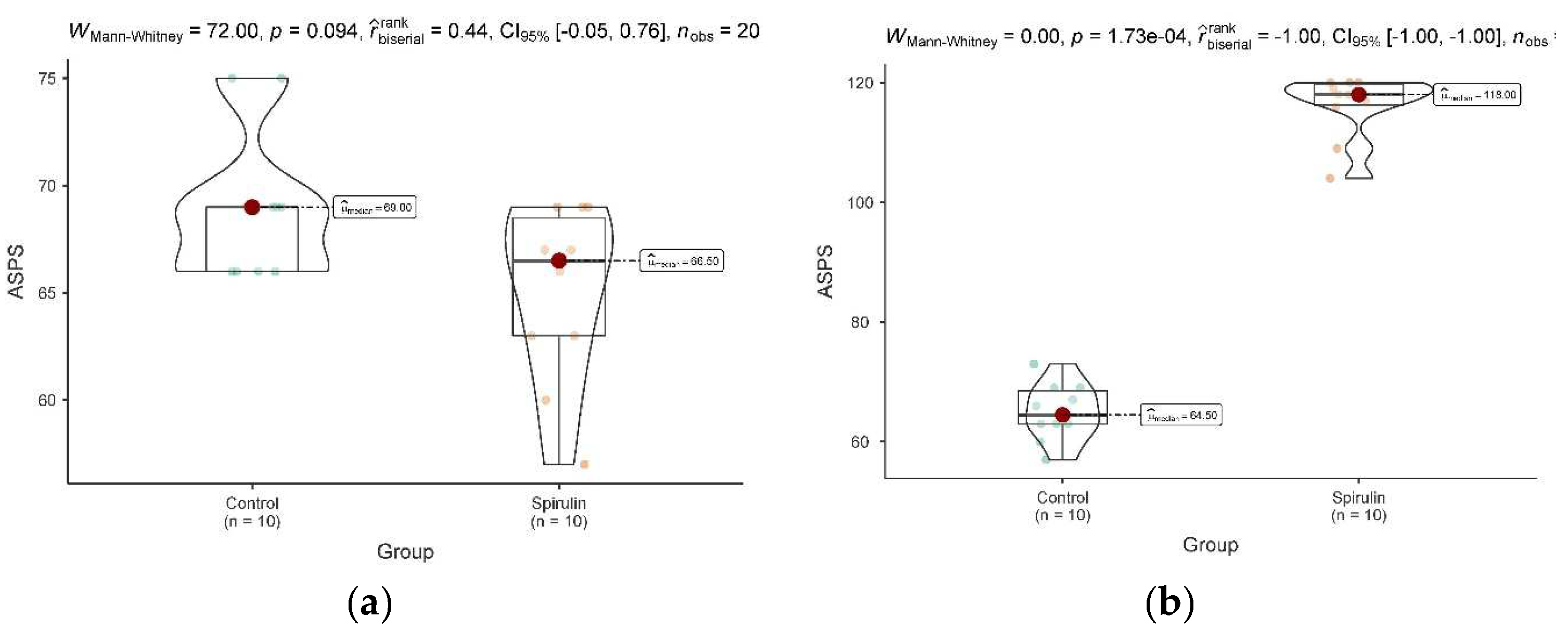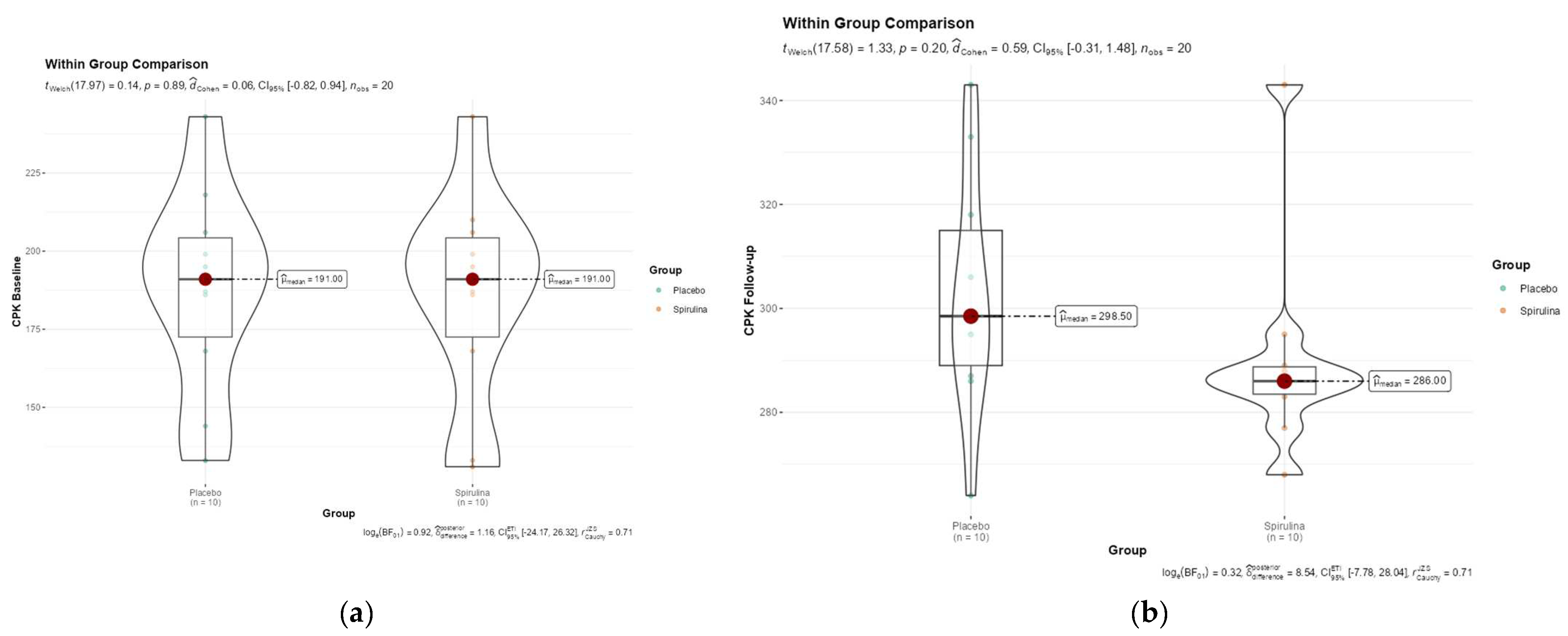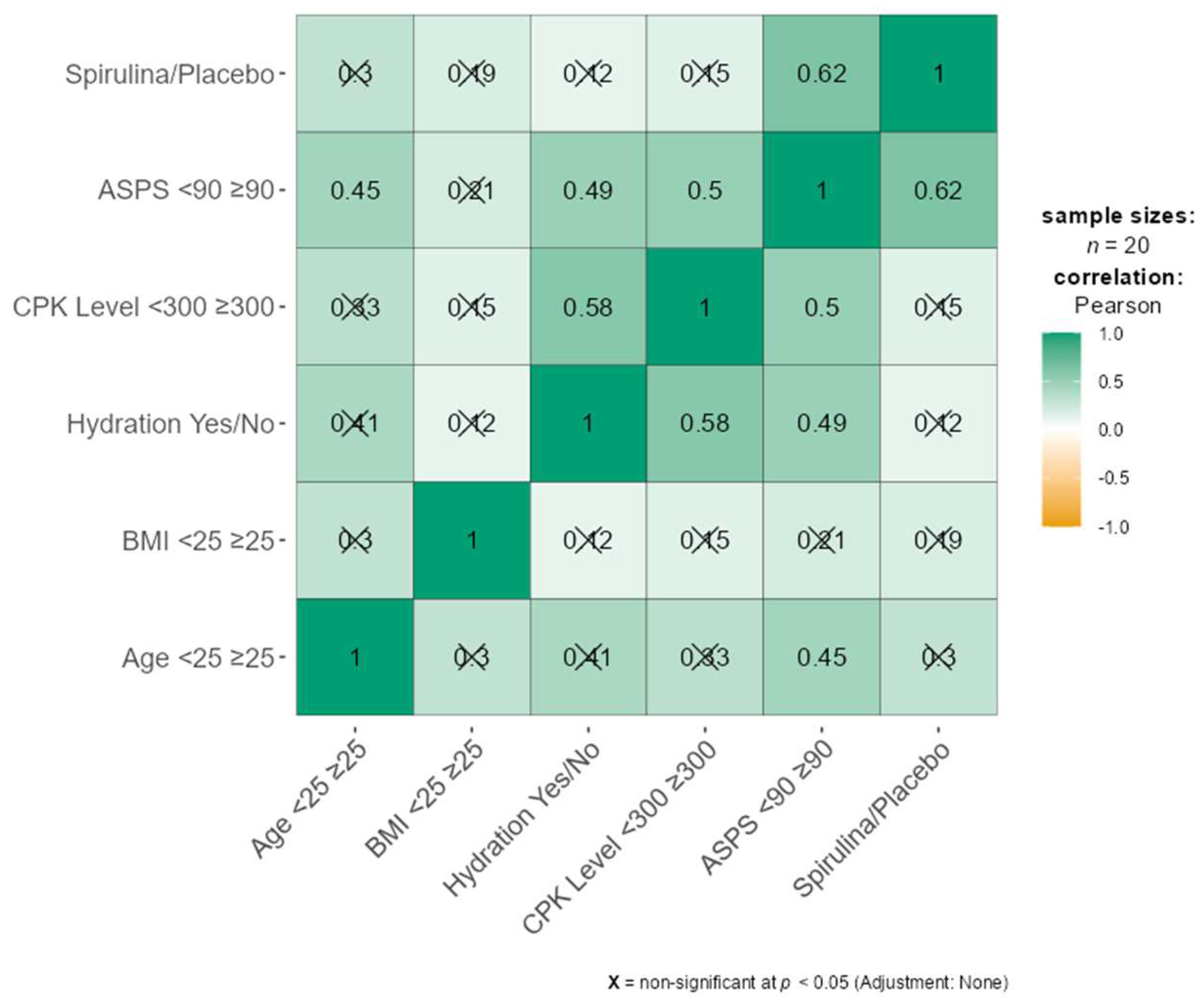Effects of a Dietary Microalgae (Arthrospira platensis) Supplement on Stress, Well-Being, and Performance in Water Polo Players: A Clinical Case Series
Highlights
- Subjective performance assessments were improved in water polo players who received a nutritional supplement including copper and spirulina for eight weeks.
- Athlete's Subjective Performance Scale (ASPS) scores were lower in the supplement group than in the placebo group, suggesting a reduction in muscle tension.
- According to the study, a dietary supplement including copper and spirulina may help water polo players' perceived performance and ease their tense muscles.
- Large-scale, randomized controlled trials are required to validate these results and investigate the possibility of this supplement improving sports performance.
Abstract
1. Introduction
2. Materials and Methods
2.1. Study Design and Participants
2.2. Training Regimen and Activity Management
2.3. Dietary Assessment and Control
2.4. Supplementation Protocol
2.5. Assessment Protocol
2.6. Statistical Analysis
3. Results
Predictors of Muscular Stress and Spirulina Consumption
4. Discussion
5. Conclusions
Supplementary Materials
Author Contributions
Funding
Institutional Review Board Statement
Informed Consent Statement
Data Availability Statement
Conflicts of Interest
References
- Maughan, R.J.; Burke, L.M.; Dvorak, J.; Larson-Meyer, D.E.; Peeling, P.; Phillips, S.M.; Rawson, E.S.; Walsh, N.P.; Garthe, I.; Geyer, H.; et al. IOC consensus statement: Dietary supplements and the high-performance athlete. Int. J. Sport Nutr. Exerc. Metab. 2018, 52, 439–455. [Google Scholar]
- Prete, V.; Abate, A.C.; Di Pietro, P.; De Lucia, M.; Vecchione, C.; Carrizzo, A. Beneficial Effects of Spirulina Supplementation in the Management of Cardiovascular Diseases. Nutrients 2024, 16, 642. [Google Scholar] [CrossRef] [PubMed]
- Delfan, M.; Saeidi, A.; Supriya, R.; Escobar, K.A.; Laher, I.; Heinrich, K.M.; Weiss, K.; Knechtle, B.; Zouhal, H. Enhancing cardiometabolic health: Unveiling the synergistic effects of high-intensity interval training with spirulina supplementation on selected adipokines, insulin resistance, and anthropometric indices in obese males. Nutr. Metab. 2024, 21, 11. [Google Scholar] [CrossRef] [PubMed]
- Ekeuku, S.O.; Chong, P.N.; Chan, H.K.; Mohamed, N.; Froemming, G.R.A.; Okechukwu, P.N. Spirulina supplementation improves bone structural strength and stiffness in streptozocin-induced diabetic rats. J. Tradit. Complement. Med. 2021, 12, 225–234. [Google Scholar] [CrossRef] [PubMed]
- Gurney, T.; Spendiff, O. Spirulina supplementation improves oxygen uptake in arm cycling exercise. Eur. J. Appl. Physiol. 2020, 120, 2657–2664. [Google Scholar] [CrossRef] [PubMed]
- Kalafati, M.; Jamurtas, A.Z.; Nikolaidis, M.G.; Paschalis, V.; Theodorou, A.A.; Sakellariou, G.K.; Koutedakis, Y.; Kouretas, D. Ergogenic and antioxidant effects of spirulina supplementation in humans. Med. Sci. Sports Exerc. 2010, 42, 142–151. [Google Scholar] [CrossRef]
- de Romaña, D.L.; Olivares, M.; Uauy, R.; Araya, M. Risks and benefits of copper in light of new insights of copper homeostasis. J. Trace Elem. Med. Biol. 2011, 25, 3–13. [Google Scholar] [CrossRef]
- Prohaska, J.R. Impact of copper limitation on expression and function of multicopper oxidases (ferroxidases). Adv. Nutr. 2011, 2, 89–95. [Google Scholar] [CrossRef]
- Close, G.L.; Hamilton, D.L.; Philp, A.; Burke, L.M.; Morton, J.P. New strategies in sport nutrition to increase exercise performance. Free Radic. Biol. Med. 2016, 98, 144–158. [Google Scholar] [CrossRef]
- Crowley, E.; Harrison, A.J.; Lyons, M. The Impact of Resistance Training on Swimming Performance: A Systematic Review. Sports Med. 2017, 47, 2285–2307. [Google Scholar] [CrossRef]
- Mirmoezzi, M.; Sayyah, M.; Taheri, M.; Irandoust, K.; Sangari, M.; Mirakhori, F.; Seghatoleslami, A.; Hill, L.; Weiss, K.; Knechtle, B.; et al. Effect of self-modeling and self-controlled feedback on the performance of professional swimmers and waterpolo players. Sports Med. Health Sci. 2023, 6, 167–172. [Google Scholar] [CrossRef] [PubMed]
- Barrenetxea-Garcia, J.; Murua-Ruiz, A.; Mielgo-Ayuso, J.; Nuell, S.; Calleja-González, J.; de Villarreal, E.S. Recovery in water polo: How much do we have to know? A systematic review. J. Exerc. Rehabil. 2022, 18, 225–234. [Google Scholar] [CrossRef] [PubMed]
- Santoro, A.; Alvino, F.; Antonelli, G.; Molle, R.; Mondillo, S. Left atrial strain after maximal exercise in competitive waterpolo players. Int. J. Cardiovasc. Imaging 2016, 32, 399–405. [Google Scholar] [CrossRef] [PubMed]
- Albert, F.J.; Morente-Sánchez, J.; Ortega, F.B.; Castillo, M.J.; Gutiérrez, Á. Usefulness of Β-Hydroxy-Β-Methylbutyrate (Hmb) Supplementation in Different Sports: An Update and Practical Implications. Nutr. Hosp. 2015, 32, 20–33. [Google Scholar] [CrossRef] [PubMed]
- Dascombe, B.J.; Karunaratna, M.; Cartoon, J.; Fergie, B.; Goodman, C. Nutritional supplementation habits and perceptions of elite athletes within a state-based sporting institute. J. Sci. Med. Sport 2010, 13, 274–280. [Google Scholar] [CrossRef]
- Gambardella, J.; Fiordelisi, A.; Spigno, L.; Boldrini, L.; Lungonelli, G.; Di Vaia, E.; Santulli, G.; Sorriento, D.; Cerasuolo, F.A.; Trimarco, V.; et al. Effects of Chronic Supplementation of L-Arginine on Physical Fitness in Water Polo Players. Oxidative Med. Cell. Longev. 2021, 2021, 6684568. [Google Scholar] [CrossRef] [PubMed]
- Tan, F.; Polglaze, T.; Dawson, B. Activity profiles and physical demands of elite women’s water polo match play. J. Sports Sci. 2009, 27, 1095–1104. [Google Scholar] [CrossRef]
- Briggs, M.A.; Cockburn, E.; Rumbold, P.L.; Rae, G.; Stevenson, E.J.; Russell, M. Assessment of Energy Intake and Energy Expenditure of Male Adolescent Academy-Level Soccer Players during a Competitive Week. Nutrients 2015, 7, 8392–8401. [Google Scholar] [CrossRef]
- Karkos, P.D.; Leong, S.C.; Karkos, C.D.; Sivaji, N.; Assimakopoulos, D.A. Spirulina in clinical practice: Evidence-based human applications. Evid. -Based Complement. Altern. Med. 2011, 2011, 531053. [Google Scholar] [CrossRef]
- Torres, C.L.; de Oliveira, F.A.G.; Jooris, L.F.; Padilha, M.C.; Pereira, H.M.G. The presence of doping agents in dietary supplements: A glimpse into the Brazilian situation. Drug Test. Anal. 2024, 16, 38–48. [Google Scholar] [CrossRef]
- Wu, Q.; Liu, L.; Miron, A.; Klímová, B.; Wan, D.; Kuča, K. The antioxidant, immunomodulatory, and anti-inflammatory activities of Spirulina: An overview. Arch. Toxicol. 2016, 90, 1817–1840. [Google Scholar] [CrossRef] [PubMed]
- Becker, E.W. Micro-algae as a source of protein. Biotechnol. Adv. 2007, 25, 207–210. [Google Scholar] [CrossRef] [PubMed]
- Von Elm, E.; Altman, D.G.; Egger, M.; Pocock, S.J.; Gøtzsche, P.C.; Vandenbroucke, J.P. The Strengthening the Reporting of Observational Studies in Epidemiology (STROBE) statement: Guidelines for reporting observational studies. J. Clin. Epidemiol. 2008, 61, 344–349. [Google Scholar] [CrossRef]
- El Kinany, K.; Garcia-Larsen, V.; Khalis, M.; Deoula, M.M.S.; Benslimane, A.; Ibrahim, A.; Benjelloun, M.C.; El Rhazi, K. Adaptation and validation of a food frequency questionnaire (FFQ) to assess dietary intake in Moroccan adults. Nutr. J. 2018, 17, 61. [Google Scholar] [CrossRef]
- Ji, Y.; Plourde, H.; Bouzo, V.; Kilgour, R.D.; Cohen, T.R. Validity and Usability of a Smartphone Image-Based Dietary Assessment App Compared to 3-Day Food Diaries in Assessing Dietary Intake Among Canadian Adults: Randomized Controlled Trial. JMIR mHealth uHealth 2020, 8, e16953. [Google Scholar] [CrossRef] [PubMed]
- Lee, S.; Yun, H.J.; Jeon, M.; Kang, M. Validating Athletes’ Subjective Performance Scale: A Rasch Model Analysis. Int. J. Appl. Sports Sci. 2023, 35, 238–250. [Google Scholar] [CrossRef]
- Ahmad, A.M.R.; Intikhab, A.; Zafar, S.; Farooq, U.; Shah, H.B.U.; Akram, S.; Abid, J.; Parveen, Z.; Iqbal, S. Spirulina, an FDA-Approved Functional Food: Worth the Hype? Cell. Mol. Biol. 2023, 69, 137–144. [Google Scholar] [CrossRef]
- Chaouachi, M.; Vincent, S.; Groussard, C. A Review of the Health-Promoting Properties of Spirulina with a Focus on athletes’ Performance and Recovery. J. Diet. Suppl. 2024, 21, 210–241. [Google Scholar] [CrossRef]
- Brito, A.F.; Silva, A.S.; de Oliveira, C.V.C.; de Souza, A.A.; Ferreira, P.B.; de Souza, I.L.L.; da Cunha Araujo, L.C.; da Silva Félix, G.; de Souza Sampaio, R.; Tavares, R.L.; et al. Spirulina platensis prevents oxidative stress and inflammation promoted by strength training in rats: Dose-response relation study. Sci. Rep. 2020, 10, 6382. [Google Scholar] [CrossRef]
- Pasiakos, S.M.; Lieberman, H.R.; McLellan, T.M. Effects of protein supplements on muscle damage, soreness and recovery of muscle function and physical performance: A systematic review. Sports Med. 2014, 44, 655–670. [Google Scholar] [CrossRef]
- Owens, D.J.; Twist, C.; Cobley, J.N.; Howatson, G.; Close, G.L. Exercise-induced muscle damage: What is it, what causes it and what are the nutritional solutions? Eur. J. Sport Sci. 2019, 19, 71–85. [Google Scholar] [CrossRef] [PubMed]
- Zhang, Y.; Zhang, Y.; Wu, W.; Xu, Y.; Li, X.; Qiu, Q.; Chen, H. Effects on Spirulina Supplementation on Immune Cells’ Parameters of Elite College Athletes. Nutrients 2022, 14, 4346. [Google Scholar] [CrossRef] [PubMed]
- Yousefian, M.; Taghian, F.; Sharifi, G.; Hosseini, S.A. High-intensity interval training along with spirulina algae consumption and caloric restriction ameliorated the Nrf1/Tfam/Mgmt and ATP5A1 pathway in the heart tissue of obese rats. J. Food Biochem. 2022, 46, e14061. [Google Scholar] [CrossRef] [PubMed]
- Lukaski, H.C. Vitamin and mineral status: Effects on physical performance. Nutrition 2024, 20, 632–644. [Google Scholar] [CrossRef] [PubMed]
- Stecker, R.A.; Harty, P.S.; Jagim, A.R.; Candow, D.G.; Kerksick, C.M. Timing of ergogenic aids and micronutrients on muscle and exercise performance. J. Int. Soc. Sports Nutr. 2019, 16, 37. [Google Scholar] [CrossRef] [PubMed]
- Burke, L.M.; Peeling, P. Methodologies for investigating performance changes with supplement use. Int. J. Sport. Nutr. Exerc. Metab. 2018, 28, 159–169. [Google Scholar] [CrossRef] [PubMed]
- Kerksick, C.M.; Wilborn, C.D.; Roberts, M.D.; Smith-Ryan, A.; Kleiner, S.M.; Jäger, R.; Collins, R.; Cooke, M.; Davis, J.N.; Galvan, E.; et al. ISSN exercise & sports nutrition review update: Research & recommendations. J. Int. Soc. Sports Nutr. 2018, 15, 38. [Google Scholar]
- Kalpana, K.; Kusuma, D.L.; Lal, P.R.; Khanna, G.L. Effect of spirulina on antioxidant status and exercise-induced oxidative stress of Indian athletes. Asian J. Sports Med. 2017, 8. [Google Scholar] [CrossRef]



| Characteristic | Placebo (n = 10) | Spirulina (n = 10) | p-Value |
|---|---|---|---|
| Age (year) | 24.7 ± 3.1 | 25.4 ± 2.9 | 0.295 |
| Weight (kg) | 75.5 ± 7.7 | 78.2 ± 14.1 | 0.289 |
| Height (cm) | 181.9 ± 5.3 | 182.1 ± 4.9 | 0.721 |
| FM (%) | 18.7 ± 4.6 | 19.5 ± 5.1 | 0.567 |
| FM (kg) | 18.1 ± 5.9 | 19.5 ± 7.2 | 0.532 |
| LBM (kg) | 77.4 ± 8.1 | 78.7 ± 8.5 | 0.578 |
| Baseline CPK (U/L) | 187.3 ± 32.56 | 186.8 ± 34.28 | 0.620 |
| Total ASPS Score (Baseline) | 69.0 ± 3.5 | 66.9 ± 4.1 | 0.154 |
| CQ | 134.1 ± 14.8 | 132.5 ± 15.3 | 0.233 |
| Years of experience | 10.2 ± 2.8 | 10.5 ± 3.1 | 0.938 |
| Training volume (hours/week) | 18.5 ± 2.3 | 19.1 ± 2.5 | 0.142 |
| Competitive level | |||
| National | 6 (60%) | 7 (70%) | 0.138 |
| Regional | 4 (40%) | 3 (30%) |
| Dietary Component | Spirulina Group | Placebo Group | p-Value | ||
|---|---|---|---|---|---|
| Baseline | Week 8 | Baseline | Week 8 | ||
| Energy (kcal/day) | 2785 ± 312 | 2798 ± 305 | 2803 ± 298 | 2815 ± 287 | 0.871 |
| Macronutrients (% of total energy) | |||||
| Carbohydrates | 52.3 ± 4.1 | 52.1 ± 3.8 | 51.8 ± 3.9 | 52.0 ± 4.2 | 0.924 |
| Proteins | 21.7 ± 2.3 | 21.9 ± 2.4 | 22.1 ± 2.5 | 21.8 ± 2.6 | 0.883 |
| Fats | 26.0 ± 3.2 | 26.0 ± 3.1 | 26.1 ± 3.0 | 26.2 ± 3.3 | 0.952 |
Disclaimer/Publisher’s Note: The statements, opinions and data contained in all publications are solely those of the individual author(s) and contributor(s) and not of MDPI and/or the editor(s). MDPI and/or the editor(s) disclaim responsibility for any injury to people or property resulting from any ideas, methods, instructions or products referred to in the content. |
© 2024 by the authors. Licensee MDPI, Basel, Switzerland. This article is an open access article distributed under the terms and conditions of the Creative Commons Attribution (CC BY) license (https://creativecommons.org/licenses/by/4.0/).
Share and Cite
La Mantia, I.; Maniaci, A.; Scibilia, G.; Scollo, P. Effects of a Dietary Microalgae (Arthrospira platensis) Supplement on Stress, Well-Being, and Performance in Water Polo Players: A Clinical Case Series. Nutrients 2024, 16, 2421. https://doi.org/10.3390/nu16152421
La Mantia I, Maniaci A, Scibilia G, Scollo P. Effects of a Dietary Microalgae (Arthrospira platensis) Supplement on Stress, Well-Being, and Performance in Water Polo Players: A Clinical Case Series. Nutrients. 2024; 16(15):2421. https://doi.org/10.3390/nu16152421
Chicago/Turabian StyleLa Mantia, Ignazio, Antonino Maniaci, Giuseppe Scibilia, and Paolo Scollo. 2024. "Effects of a Dietary Microalgae (Arthrospira platensis) Supplement on Stress, Well-Being, and Performance in Water Polo Players: A Clinical Case Series" Nutrients 16, no. 15: 2421. https://doi.org/10.3390/nu16152421
APA StyleLa Mantia, I., Maniaci, A., Scibilia, G., & Scollo, P. (2024). Effects of a Dietary Microalgae (Arthrospira platensis) Supplement on Stress, Well-Being, and Performance in Water Polo Players: A Clinical Case Series. Nutrients, 16(15), 2421. https://doi.org/10.3390/nu16152421








